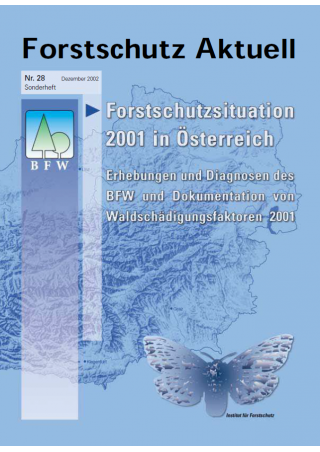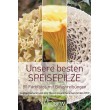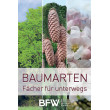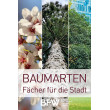Forstschutz Aktuell 28/2002
Steyrer G., Cech T.L., Fürst A., Krehan H., Krenmayer W., Kristöfel F., Perny B., Schaffer H., Stagl W.G., Tomiczek C.: Forstschutzsituation 2001 in Österreich - Erhebungen und Diagnosen des BFW und Dokumentation von Waldschädlingsfaktoren 2001. 66 S.
Summary
In the year 2001, more than 650.000m3 bark-beetle infested wood was cut. This is a bit more than during the years before. The most dangerous species is Ips typographus which feeds on Norway spruce, but in some regions also Pityogenes chalcographus, on young spruce stands, and Tomicus minor and T. piniperda, on Scots pine, attacked a large amount of trees. The Gregarious spruce sawfly (Pristiphora abietina) was found in many secondary spruce-stands in Upper and Lower Austria. In Carinthian pine stands, the gradation of Neodiprion sertifer is still going on, but without causing severe damages.
A very important vector of pine decline in Styria and Burgenland is the buprestid beetle Phaenops cyanea. Damages of pine weevil (Hylobius abietis) on conifers and Dreyfusia-aphids on silver fir are also reported. Random sampling showed that the two leave mining moths of black locust, Phyllonorycter robiniella and Parectopa robiniella, have infested nearly the whole area of Eastern Austria, where Robinia pseudoacacia occurs. Often, they are found at high densities, without making severe damages to their host trees. The Gleditsia pod gall midge (Dasyneura gleditsiae) which was recorded for the first time in Austrian forests on the occasion of a mass outbreak in a tree nursery in the Burgenland in 2000, showed no remarkable densities on this 4 ha area in 2001. The occurrence in urban trees (Vienna, Baden near Vienna) showed the same density as in 2000.
The weevils Polydrusus spp. and Phyllobius arborater were reported to infest spruce, larch and Douglas fir and Christmas tree plantations from fir in Styria, Upper and Lower Austria. Synanthedon cephiformis was found in an Abies nordmanniana plantation.
Scleroderris-disease (Ascocalyx abietina) was reported in 2001 only from a few stands of Swiss stone pine (Pinus cembra), probably as a result of local microclimatic conditions.





